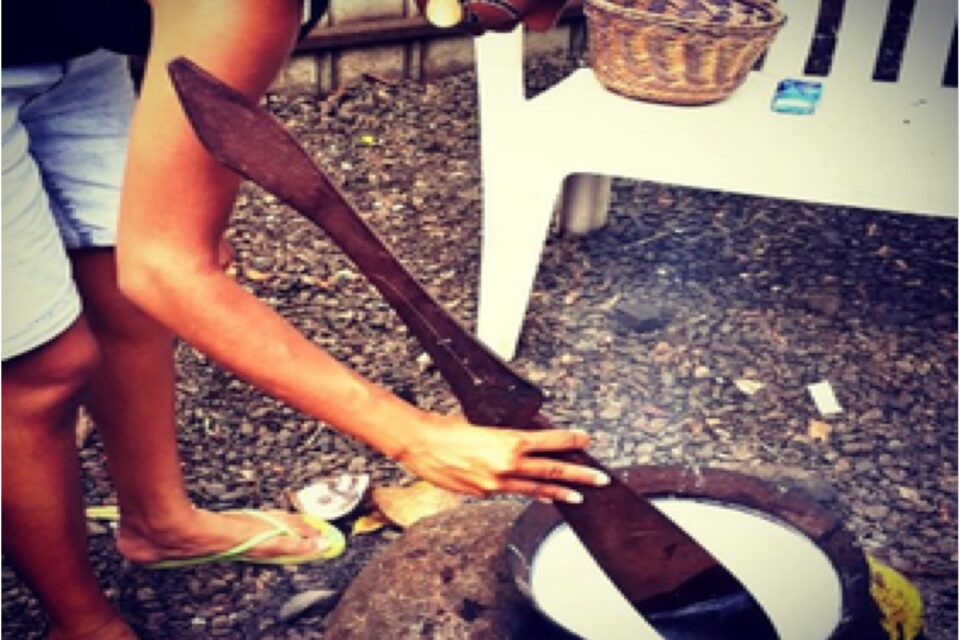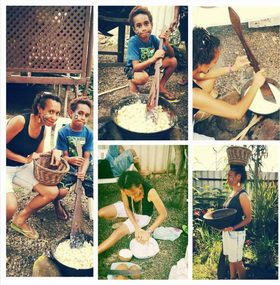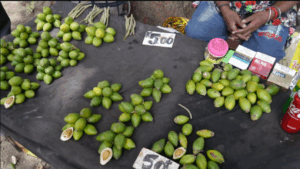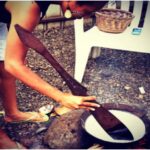Sha Amos shares a recipe for ‘Mona,’ a traditional Milne Bay dish

This dish, while not specifically a dessert dish since it is part of the mainstay during any family gathering, is on the sweeter side and brings back many fond memories of my childhood. Mona, a traditional dish made by the Dobuan people of Milne Bay, is like a thickened coconut dumpling porridge. Mona dumplings can be made with taros, cooking bananas, sago, and more recently, plain flour.
To start, an insane amount of coconut is finely scraped, and the coconut milk is extracted to halfway fill a clay pot. The coconut-filled clay pot is then put atop a fire and slowly heated using a custom-made wooden paddle called a “Panum.” A specific green leaf within the Tanget family is crushed and immersed into the coconut mixture while being heated to give it its greenish tinge color and a subtle taste profile. The taro or banana is peeled and cut into 2cm chunks, and for flour mona, the flour is mixed with water to form a pliable dough.
Once the coconut milk is brought to a boil, the chunks of taro or banana are slowly added to the mixture, and if making flour mona, small round or tubular-shaped dough is formed and then each piece is individually immersed into the coconut mixture. The mona dish must go through two boils. During the first boil, the coconut oil separates and forms on top, which can be siphoned off and used for cooking other foods later. In the second boil, the mona dish is ready.
Teste island delicacy…..Mona pic.twitter.com/dtQrgdHTG5
— Juliet Mike (@jahmehz71) November 6, 2022

The mona dish is a labour of love and a consistent favourite at any gathering. It brings back fond memories of my grandparents, my paternal family, and a sense of community. The Dobuan Mona dish is no different, and if ever invited to a Dobuan gathering, be sure to look out for the soot-ridden clay pot atop a dinner table and indulge in a generous serving of Mona before it’s all gone.
This dish, while not specifically a dessert dish since it is part of the mainstay during any family gathering, is on the sweeter side and brings back many fond memories of my childhood. Mona, a traditional dish made by the Dobuan people of Milne Bay, is like a thickened coconut dumpling porridge. Mona dumplings can be made with taros, cooking bananas, sago, and more recently, plain flour.
To start, an insane amount of coconut is finely scraped, and the coconut milk is extracted to halfway fill a clay pot. The coconut-filled clay pot is then put atop a fire and slowly heated using a custom-made wooden paddle called a “Panum.” A specific green leaf within the Tanget family is crushed and immersed into the coconut mixture while being heated to give it its greenish tinge color and a subtle taste profile. The taro or banana is peeled and cut into 2cm chunks, and for flour mona, the flour is mixed with water to form a pliable dough.
Once the coconut milk is brought to a boil, the chunks of taro or banana are slowly added to the mixture, and if making flour mona, small round or tubular-shaped dough is formed and then each piece is individually immersed into the coconut mixture. The mona dish must go through two boils. During the first boil, the coconut oil separates and forms on top, which can be siphoned off and used for cooking other foods later. In the second boil, the mona dish is ready.
The mona dish is a labour of love and a consistent favourite at any gathering. It brings back fond memories of my grandparents, my paternal family, and a sense of community. The Dobuan Mona dish is no different, and if ever invited to a Dobuan gathering, be sure to look out for the soot-ridden clay pot atop a dinner table and indulge in a generous serving of Mona before it’s all gone.






